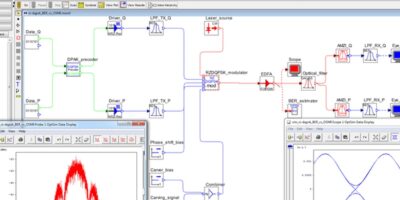Synopsys enhances Photonic Solutions for AR/VR optics
Version 2020.03 of Synopsys’ Photonic Solutions design portfolio includes the RSoft Photonic Device Tools, the Photonic System Tools, and the PIC Design Suite for photonic integrated circuit (PIC) design. According to Synopsys, it offers the industry’s only seamless design flow, for consumer and industrial communication, sensing, and imaging applications from concept to manufacturing.
The latest release has the capability to optimise nanoscale and macroscale illumination optics in an integrated environment for the stringent performance, functionality, cost, and size requirements of augmented reality / virtual reality (AR/VR) devices. There are also tools to accelerate the design of PICs and photonic systems for aerospace and defence, 5G and long-haul data networks.
The RSoft Photonic Device Tools provide simulators and optimisers for passive and active photonic and optoelectronic devices, including lasers and vertical-cavity surface-emitting lasers (VCSELs) all of which are integrated with Synopsys’ optical and semiconductor design tools for complete, multi-domain co-simulations.
The RSoft-LightTools Bidirectional Scattering Distribution Function (BSDF) interface produces interpolated BSDF files that allow designers to optimise nanoscale and macroscale optics directly in LightTools. This is especially useful for optimising performance of AR/VR system components, including freeform optical prism projectors, eye tracking technologies, and optical planar waveguides with diffraction gratings, says Synopsys.
An expanded Custom PDK Utility allows designers to create PDK device models using co-simulation between the RSoft Photonic Device Tools and Sentaurus TCAD. The seamless integration of these tools for semiconductor process and photonic device simulation produces accurate, complete optoelectronic models for modulators and detectors. An example model provided with the software demonstrates how the Custom PDK Utility can be used to create ring and linear modulators.
The Photonic System Tools, including OptSim (pictured) and ModeSYS, simulate the performance of optical communication system links through comprehensive simulation techniques and component models. New features include application notes and example models to jumpstart designs for long-haul data networks, aerospace and defence systems and 5G and free-space optical communication systems.
An enhanced bi-directional multi-port model in OptSim Circuit for characterising passive photonic devices in terms of an S-matrix (scattering matrix) to support both non-uniform frequency and wavelength data
There is also improved simulation of compact models produced by the Custom PDK Utility. These models now include options for wavelength grouping data for more accurate phase estimation when using a coarse parametric grid
There are application notes and example models available to jumpstart PIC designs for data centre interconnects and sensors
The ability to export OptoDesigner files to the DXF file format, allows PIC designs to be easily transferred to CAD programs such as SolidWorks and AutoCAD.




